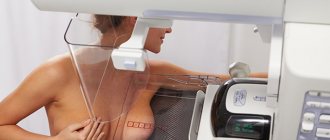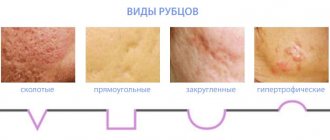Breast reduction surgery
consists of removing excess skin, fatty tissue, breast tissue and moving the nipple-areolar complex to a higher position. The suture for reduction mammoplasty is called “anchor” and is located around the areola, vertically down and in the fold under the breast. There are also other variations of cuts; you can learn more about them here.
Causes of gigantomastia, hypermastia
Gigantomastia
- This is an extreme degree of enlargement of the mammary glands.
In numbers, gigantomastia or hypermastia is classified as an increase in the mass of the mammary gland by 1200 g (or volume by 1200 ml) or the size of the mammary glands - an eighth or more. Smaller breasts are classified as mammary hypertrophy
.
In adolescence, gigantomastia can develop over a fairly short period - from 6 to 12 months and is most often accompanied by the appearance of skin stretch marks. Excessive enlargement of the mammary glands during adolescence is most often associated with hormonal imbalances
(hormones estrogen, progesterone, prolactin, somatotropin). In this case, parents of such girls and young women are recommended to consult a gynecologist-endocrinologist and undergo corrective therapy.
There are several reasons for this phenomenon:
these are heredity, endocrine disorders, metabolic disorders (obesity), and an excessive increase in the volume of the gland can occur after childbirth and breastfeeding. If the main reason for the increase in the volume of the gland is endocrine disorders, then in addition to surgical treatment, the patient should undergo treatment by an endocrinologist.
The main complaints with gigantomastia and hypermastia:
- Pain in the cervical, thoracic, lumbar spine;
- Discomfort associated with physical activity, selection of clothing, intimacy;
- Skin changes: diaper rash, sweating of the inframammary fold area;
- Reproductive dysfunction (difficulty getting pregnant).
Difficulties of breast reduction surgery. Evolution of techniques
Breast reduction surgery techniques have undergone some evolution. Previously, one might say, mutilating breast reduction techniques were used. For example, one of the techniques simply involved excision of the nipple-areolar complex and the formation of a new one from the skin, and an imitation of the areola was subsequently applied using tattoo pigment. Later, free transplantation of the nipple-areolar complex began to be used - in fact, the nipple was cut off and transplanted onto a prepared bed in the projection zone of the inframammary fold; this technique also gave a number of complications associated with malnutrition of the nipple-areolar complex.
How is breast reduction surgery performed today?
Today we can safely say that reduction mammoplasty techniques have been refined and allow for a voluminous and safe reduction of the gland in one go. Although, it should be noted that some surgeons still offer breast reduction in two stages, and this is justified when it comes to extremely large breasts. Modern surgical techniques eliminate disruption of the blood supply and sensitivity of the nipple.
The operation is performed using endotracheal anesthesia (general anesthesia). The duration of the operation, depending on the volume of tissue removed, is from 2.5 to 4 hours. The operation is voluminous and complex. The complexity is due to the fact that such a gland is usually strongly lowered in relation to the inframammary fold (inframammary fold). The distance of the nipple-areolar complex in relation to this fold can reach up to 30 cm, and the weight of the mammary gland itself can be 10 kg or more.
Indications
The main reason for breast reduction surgery is dissatisfaction with its appearance. In addition, reduction mammoplasty can solve the following problems:
- pain in the back, neck and chest;
- labored breathing;
- curvature of the spine and poor posture;
- diaper rash and itching under the breasts, chafing on the shoulders from the straps;
- limitation of physical activity due to hypertrophied mammary glands;
- ptosis (drooping) of the juice-areolar complex;
- chronic pain in the shoulders, neck, lower back.
Breast lift: preoperative markings
There are many schemes and even marking templates (even patterns) proposed by various surgeon authors. Their number is probably comparable to the many different methods of vertical breast lift (at least several dozen). In his practice, a plastic surgeon, having gone through a certain path and tested many of the proposed methods, usually “calms down” on several of them (usually 3-4). The choice, as a rule, remains with those methods of operation (and, accordingly, marking), as a result of which this particular surgeon obtains the best results. Of course, it is pointless to try all the methods of operation proposed by various authors. Life simply isn't enough for this. Next, the practicing surgeon only brings to “perfection”, polishes the technique of a particular method. And sometimes he supplements the method of operation used with his own nuances, not forgetting to add his last name to an already well-known author in some publications. And in some cases, you can even forget to mention the original source... But this is already lyrics.
In our particular case, I planned to perform a vertical breast lift using an inferior Ribeiro flap. True, in some modification, having spotted this moment at one of the regular events (master classes). Accordingly, the marking, let’s call it a work plan, was carried out based on the chosen method of operation. I will only note the main most important points of marking, on which the result of the operation largely depends. First, the midline is marked from the jugular notch to the xiphoid process. Next, a perpendicular line at the level of the inframammary groove is projected onto it (the midline) (some people are more accustomed to hearing the “inframammary fold”). It is very important to mark the meridian as accurately as possible (to be honest, “by eye” - mathematics will not help here) - a line running from the collarbone through the middle of each mammary gland. This line does not necessarily go through the nipple. As, for example, in this case: the SAH is not in the center of the chest - it is shifted outward. Therefore, the meridian runs a little more medially (inward) from the nipples. The meridian line runs through the entire chest and continues to the chest wall (you can see this in the photo with raised arms).
After the meridian is marked, we determine the upper limit of the edge of the future displaced areola. To do this, measure 4 or 5 cm (depending on what level we want to see the “new” NAO) on the midline and project a perpendicular onto the meridian line. This is a very important point! After all, if the surgeon does not take into account the physical properties of the “filler and cover” and cannot correctly predict the result of a breast lift (that is, postoperative natural gravitational ptosis of the breast), then this author may find himself in an “awkward” position. And the formed SAC will look like a button “highly sewn” to the chest. Correcting this situation (lowering the SAC lower) will not be very, very easy. As you correctly understood, it’s better to under... than
Next we need to mark the lateral boundaries of the vertical leg. This is where we need the meridian line below the chest. Using his palm, the surgeon slightly shifts the breast alternately to the right and left, projecting (marking with a marker) the vertical line of the meridian onto the mammary gland. There is very little left. Connect all these points (upper border of the areola, points of the vertical leg) into one drawing. Around the SAC, the pattern resembles a “mosque roof” - these are the boundaries of the skin being removed. The picture below resembles half a leaf, for example, a birch tree. Even if this seems quite difficult to you for now, I hope that the further course of the breast lift operation will put everything in its place.
All other mathematical calculations and proposals in practice can be erroneous and sometimes even harmful. It is impossible to use standard criteria and numbers when labeling in a stereotyped manner; for all patients in a row. For example, “the distance from the jugular notch to the nipple should be 19 -21 cm,” some authors write. Others argue that if the distance from the nipple to the inframammary groove is more than 7-8 cm, you need to do an anchor lift of the mammary glands, etc. I repeat once again - there are a lot of physical factors of breast tissue that cannot be measured by any mathematical measurements. Plus the individual initial breast structure of each individual, plus wishes for the future shape and much, much more.
Prices for services
| Price | On credit* | |
| Reduction mammoplasty (breast reduction) using an inverted approach (size mf to size E) | 220,000 rub. | from RUB 21,985/month |
| Reduction mammoplasty (breast reduction) using an inverted approach (breast size larger than E size) | 280,000 rub. | from RUB 27,981/month |
| Correction of gynecomastia - reduction of the mammary glands in men with gynecomastia (primary) | 52,000 rub. | from RUB 5,196/month |
| Correction of gynecomastia - reduction of the mammary glands in combination with liposuction | 92,000 rub. | from RUB 9,194/month |
| Consultation with a plastic surgeon for surgery | 0 rub. | — |
Average cost of services
You can find out how much our plastic surgery services cost on average by calling in St. Petersburg: +7
SM-Clinic surgeons will develop an individual operation plan for you, since surgical body correction is often planned and carried out in a complex manner. The exact cost is calculated individually after consultation with a doctor.
Plastic surgery on credit and in installments
Kinds
Reduction mammoplasty can be performed in two ways, which differ in the types of incisions:
- Vertical - around the areola and vertically to the fold under the breast. This method is the least traumatic, but is only suitable for a small amount of work.
- Anchor or T-shaped - in addition to the vertical incision, an incision is made in the inframammary fold (under the breast). This method is necessary when the gland is greatly reduced (from 500 grams). The seam in this case will be more noticeable.
Promotion
Methods for restoring the nipple-areolar complex
Often, breast reconstruction surgery is accompanied by restoration of the nipple and areola. This is a separate plastic surgery that is performed after the main reconstructive mammoplasty procedure. A prerequisite is that the patient completes the course of adjuvant therapy (taking medications after radical surgery).
It is possible to reconstruct the nipple and areola from the same tissues of the second breast. This is a painstaking process and sometimes requires re-adjustment as the nipple may become flattened. It is possible to recreate the nipple from tissue from the reconstructed breast. In this case, the simplest option for creating an areola is tattooing.
Tissue transplantation of the labia minora will allow you to achieve identical color. It is also possible to use donor material.
Get a free consultation from Dr. Granado
A unique opportunity, get a free consultation in Russian from Dr. Granado Tiagonse.
- Fill out the application for consultation
- Upload three photos of the problem area from three angles
- Describe your problem in detail
- Send your request to us
- In a few days you will receive an answer in Russian from Dr. Granado
Fill out the application
Contraindications
As with any surgical intervention, there are a number of contraindications for breast reduction surgery:
- minor age;
- period of pregnancy, lactation and planning of children;
- blood diseases (clotting disorders, low hemoglobin levels, etc.);
- infectious diseases and inflammation;
- oncological diseases;
- diabetes;
- true hormone-dependent gigantomastia;
- formations in the mammary glands.
Plastic surgeons at the clinic
Davydov Alexander Sergeevich
Experience - 14 years
Head of the Department of Plastic Surgery. Leading plastic surgeon. Certified specialist in plastic surgery and general surgery. Participant in master classes on plastic surgery.
Yakimov Dmitry Konstantinovich
Experience - 38 years
Doctor of the highest category. Candidate of Medical Sciences. Member of the Society of Plastic Surgeons. Author of more than 30 works in the field of surgery, teacher at the Military Medical Academy.
Gvaramiya Eka Yurievna
Experience - 17 years
Participant of congresses, conferences and seminars on plastic surgery. Priority areas: mammoplasty (breast plastic), blepharoplasty, tummy tuck (abdominoplasty), liposuction, lipofilling, face lift, lip plastic, ear plastic, intimate plastic, body plastic, reconstructive plastic, solving aesthetic problems.
Abzaleva Guzel Rinatovna
Experience - 15 years
Participant of congresses, conferences and seminars on plastic surgery. Priority areas: blepharoplasty, lipofilling, intimate plastic surgery, abdominoplasty, breast plastic surgery.
Kalita Valeria Denisovna
Experience - 4 years
Participant of congresses, conferences and seminars on plastic surgery. Priority areas: mammoplasty, blepharoplasty, liposuction, abdominoplasty.
Makarov Andrey Vitalievich
Experience - 18 years
Certified specialist in plastic surgery, maxillofacial surgery, otolaryngology, general surgery. Participant in master classes on facial plastic surgery and rhinoplasty in Russia and abroad.
Garifulin Marat Sagitovich
Experience - 19 years
Priority areas: mammoplasty and gynecomastia (including in men), waist shaping, blepharoplasty, otoplasty, abdominoplasty.
Possible complications
After reconstruction, complications typical of any surgical intervention are possible: the formation of edema and hematomas, the appearance of scars, infection of the suture site, loss of skin sensitivity. Deformation of tissues and implants is also possible, and the expected result does not correspond to reality, which will require additional intervention.
The most unfavorable complication is considered to be rejection of the transplanted flap, tissue necrosis. In the area of the donor site of the body, displacement of tissues and muscles and complications associated with wound healing may also be observed.
Operation
The operation is performed under general anesthesia. The duration of the procedure depends on the amount of work and the chosen technique: all this will be determined during consultation with the surgeon. On the day of surgery, the patient is not allowed to eat.
Breast reduction is carried out in several stages:
1. Applying markings to the skin.
2. Cutting the skin in accordance with the markings.
3. Determining the size of the areola.
4. Excision of excess skin and internal tissues.
5. Moving the nipple and areola to a new location while preserving the nerve endings and blood vessels, as well as the milk ducts.
6. Sutures: first internal deep, and then cosmetic.
Rehabilitation after reduction mammoplasty
During the first few days you may experience severe pain, so your doctor will prescribe pain medications. The postoperative dressing will be removed approximately on the second or third day. From this time on, it is necessary to wear special compression garments, which provide the necessary pressure and promote rapid healing of the sutures. The woman can return home. But you should lead a gentle lifestyle during the first 1.5-2 months: completely eliminate physical activity, avoid sudden movements. The doctor will remove the stitches 10-14 days after surgery. Until this time, you can only sleep on your back. If the stitches are applied correctly and carefully, then after six months the scars will be almost invisible.
As a result of breast reduction, women note a significant improvement in well-being and quality of life.







